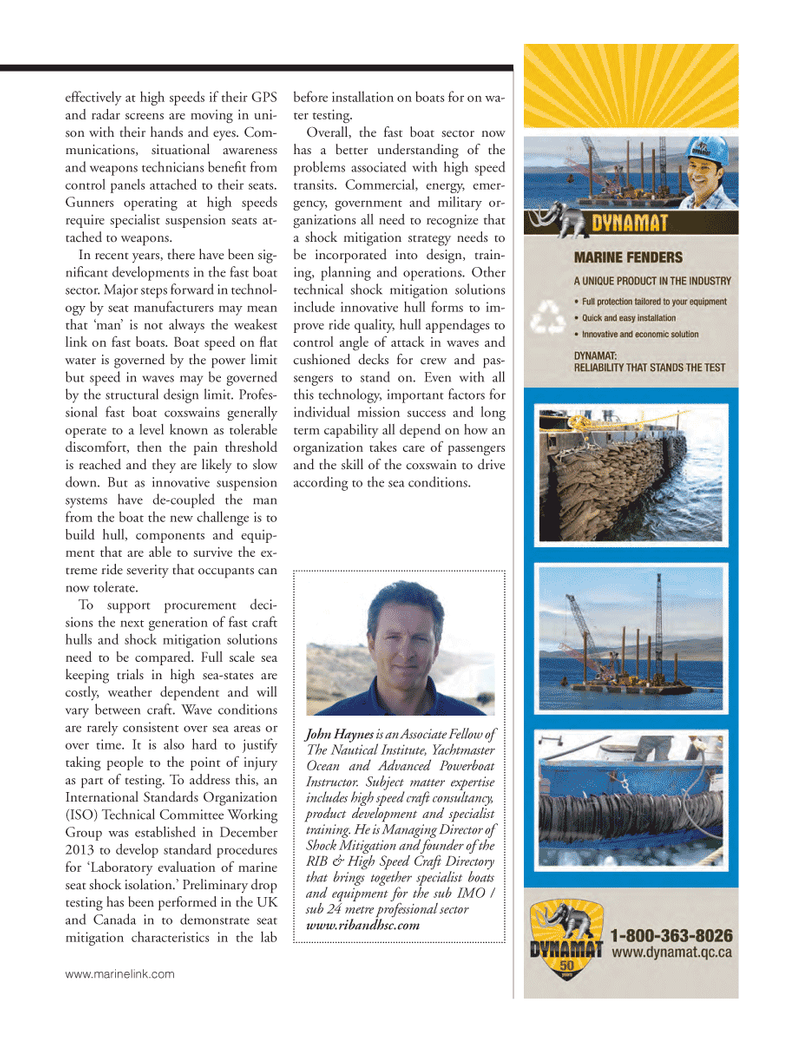
Page 75: of Marine News Magazine (November 2014)
Workboat Annual
Read this page in Pdf, Flash or Html5 edition of November 2014 Marine News Magazine
effectively at high speeds if their GPS and radar screens are moving in uni- son with their hands and eyes. Com- munications, situational awareness and weapons technicians benefi t from control panels attached to their seats.
Gunners operating at high speeds require specialist suspension seats at- tached to weapons.
In recent years, there have been sig- nifi cant developments in the fast boat sector. Major steps forward in technol- ogy by seat manufacturers may mean that ‘man’ is not always the weakest link on fast boats. Boat speed on fl at water is governed by the power limit but speed in waves may be governed by the structural design limit. Profes- sional fast boat coxswains generally operate to a level known as tolerable discomfort, then the pain threshold is reached and they are likely to slow down. But as innovative suspension systems have de-coupled the man from the boat the new challenge is to build hull, components and equip- ment that are able to survive the ex- treme ride severity that occupants can now tolerate.
To support procurement deci- sions the next generation of fast craft hulls and shock mitigation solutions need to be compared. Full scale sea keeping trials in high sea-states are costly, weather dependent and will vary between craft. Wave conditions are rarely consistent over sea areas or over time. It is also hard to justify taking people to the point of injury as part of testing. To address this, an
International Standards Organization (ISO) Technical Committee Working
Group was established in December 2013 to develop standard procedures for ‘Laboratory evaluation of marine seat shock isolation.’ Preliminary drop testing has been performed in the UK and Canada in to demonstrate seat mitigation characteristics in the lab before installation on boats for on wa- ter testing.
Overall, the fast boat sector now has a better understanding of the problems associated with high speed transits. Commercial, energy, emer- gency, government and military or- ganizations all need to recognize that a shock mitigation strategy needs to be incorporated into design, train- ing, planning and operations. Other technical shock mitigation solutions include innovative hull forms to im- prove ride quality, hull appendages to control angle of attack in waves and cushioned decks for crew and pas- sengers to stand on. Even with all this technology, important factors for individual mission success and long term capability all depend on how an organization takes care of passengers and the skill of the coxswain to drive according to the sea conditions.
John Haynes is an Associate Fellow of
The Nautical Institute, Yachtmaster
Ocean and Advanced Powerboat
Instructor. Subject matter expertise includes high speed craft consultancy, product development and specialist training. He is Managing Director of
Shock Mitigation and founder of the
RIB & High Speed Craft Directory that brings together specialist boats and equipment for the sub IMO / sub 24 metre professional sector www.ribandhsc.com www.marinelink.com
MN Nov14 Layout 66-81.indd 75 10/23/2014 10:46:34 AM

 74
74

 76
76
